The saying “Life begins at the end of your comfort zone” is proven to be true so far, but it doesn’t mention that comfort zones are very tricky. Nicolas had let me camp in the conference room, where I could store my bike, and had electricity and internet. It has been one month I am wearing only flip flops and cycled only short distances to get food. I was back in a comfort zone, and the idea of packing heavy stuff on my bike and cycle again in the dust was not motivating me.
By 12, I have repacked all my things and leave definitely the campement for Dakar, pushed by the need of the bike maintenance that I couldn’t perform properly yesterday. Wearing my closed trail shoes feels strange. I keep my short sleeve shirt. I had been wearing long sleeves in the Sahara to protect from the sun, but I switched for short sleeves during my holidays.
The first meters on the saddle feel wrong. Is it normal the bike is so heavy? Did I really cross mountain passes with this?
Before even leaving Mboro, I am stopped by a young Chinese man. He’s also a cyclist. It’s his 4th year on the road, of a 10-year journey. His goal is to beat a world record, I don’t really know which one, but he has a letter written by the Chinese government that backs him up for it. With no French and almost no English, 10 years cycling foreign countries must be long …
Dakar is 100 km away. With this late departure, I plan to arrive just before the start of the urbanization, camp, and enter the city tomorrow with plenty of time. We can never tell how long it takes to enter a big city. I remember in Spain, I was arriving in Valencia in the late afternoon. The city was just there, I felt I was in. But in the end, I had 2 hours of night cycling, in between highways and industrial zones, trying to find a route to the city center. I don’t want to repeat this bad experience, as Dakar can’t be better than Valencia.
I follow the coastal road, through Bayakh, Notto, until the Lac Rose. The road is very bad, a true pothole collection. We had taken it with the Ndiaga Ndiaye, the bush taxi, and it took ages. The minivan was driving off the road, on the two tracks that appeared on both sides of the (now narrow) asphalt, blowing dust into the eyes of all the passengers.
However, with the bicycle, it’s a pleasure: the road is empty apart from the bush taxis from time to time. I can slalom between the potholes without braking and stay on the asphalt. I slowly forget the weight I am pulling, getting re-accustomed to it. The many villages are full of kids, waving at me by the road and shouting “Bonjour Toubab!“, or just shouting impulsive noises to express the surprise of seeing a Toubab from that close on this road. I feel like in a race with many spectators.
The kids are much nicer than on the main roads, but a few “give me your bike” or “give me the money” from time to time remind me that there is no such thing as a race. Instead, I naturally cycled all the way to their village to distribute money, and eventually to hand out my bicycle.
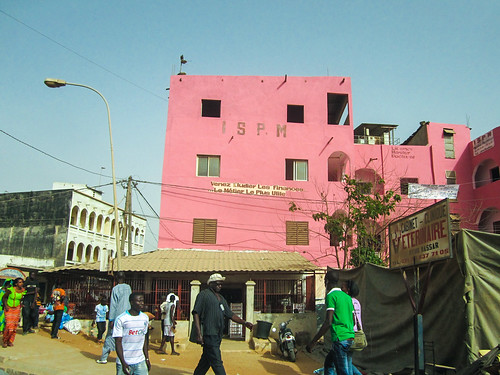
I am not stopping often and I end up quickly at the gates of Dakar suburbs, where the trucks suddenly appear in numbers among markets stalls that are taking over the roads. I remember a blog post of geocyclab talking about a 30 m wide bicycle path, and it appears just now: the new Dakar highway is in front of me. Instead of taking a bridge crossing it, I can ride the closed access ramp, passing through the big stones blocking the entrance. There I am alone on the highway which is due to open soon. One leg near Rufisque is already open, but the rest of it, from Rufisque to Dakar, still lacks some painting, the water drains and some toll gates.

I am speeding inside Dakar on my special road and will reach the capital soon. At the end of the highway, I meet another cyclist going to work and he guides me through the busy roads of the city center. Luckily, in the evening, most of the traffic is leaving the capital, so entering it through Hann is not too dangerous. But once inside HLM, Liberté, Sacré-Coeur, it’s a lawless jungle. Cars hardly drive faster than the pedestrians walk. Roundabouts are the most static places of the road network. I am moving carefully making sure every driver notices me and end up at the guest house I already stayed twice at. Alive! The day went much better than I expected and I am relieved.
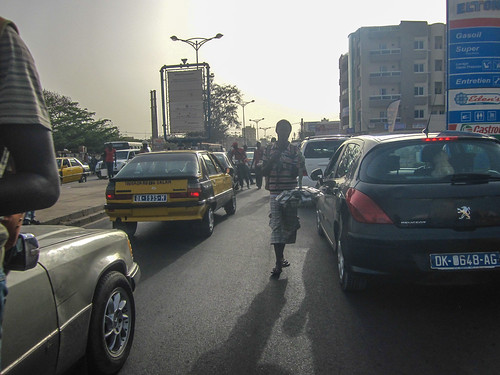
However, at the guesthouse the dorm is closed today. I can’t stay here. I can take a room for 20’000 CFA, but I’m not in good terms with Dakar accommodation, full of overpriced rooms with bugs and a few drops of hot shower. Morocco was a cheap paradise in comparison, where all towns offer basic rooms for 50 dirhams.
So I am left in Dakar with 1 hour of daylight and the mission of finding a correct place to stay. I roam around Medina, the neighborhood of my targeted bike shop, as I was told it has places to sleep. But I spot none. It gets darker and I am still outside. I must keep an eye on everything, people, animals, cars, taxis, while looking for signs of accommodation. It’s a highly stressing and intense exercise. After many days spent in Dakar, I feel confident in the town, but still bearing in mind that I should not be around the Corniche at night. It doesn’t lack crime stories. On my bike, I am always directed further away and as the public lighting start to be more useful than the ambient light. I stop roaming around to bang on a large metallic door reading “Orphanage and Foyer”. The place is not a registered accommodation but it luckily appears to have rooms for rent to fund their activities.
There, I discover that my idea of testing the short-sleeve shirt is not a good one.
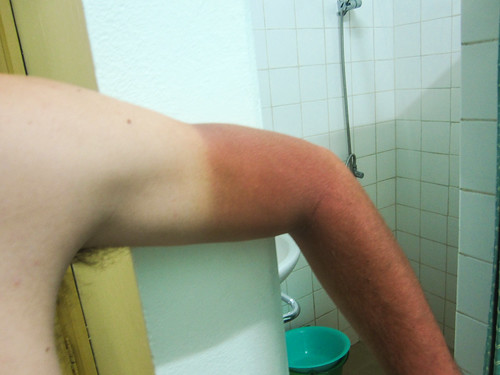
At least, I am now close to the shop and will be able to get there early the next morning.
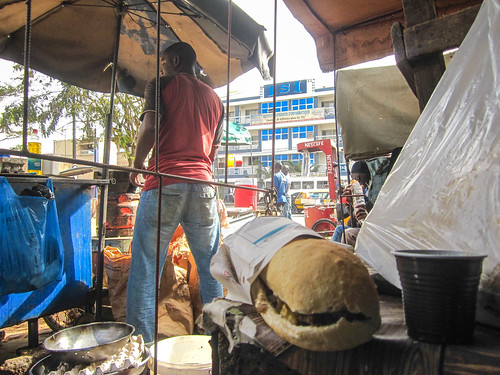
What I like about Dakar is the ubiquitous Nescafé on wheels. They’re not limited to Dakar, but they’re present in every corner of the capital. They have hot water and offer nescafé sticks (with foam like the Mauritanian tea) for 50 CFA in 20 seconds. 50 CFA gets a small cup in Dakar, while it’s a big cup outside.
The bike shop I head to is a Decathlon-like store called CitySport. It’s only in Dakar and sells many articles from GoSport. The guard tells me the story of the current owner, a Lebano-Senegalese who started in Dakar with one shop, and now a multi-billionaire living in Monaco, owning many huge stores alike all across Africa and shareholder of GoSport.

The bicycle articles are seemingly 50% or 100% pricier than in a GoSport in Europe, but I’m not coming for that. I spend the next 4 hours with the technician responsible for the bikes, Youssouf, and it’s a pleasure to work with someone who doesn’t repair bikes with a hammer and a chisel. He doesn’t know Rohloff, but with my theoretical knowledge we manage to reverse the sprocket. At first, it didn’t come off at all, unlike in the easy looking video. We needed to be 3: one to hold the wheel, one with the chain whip inside a long pipe to make a longer lever, and one on the wrench with a longer lever too.
The sprocket bears the obvious marks of the kilometers: the teeth are dug on one side. The chain has to be changed to, because it got worn with the sprocket and would slip if used on the new side. By the way, the chain had 100 links and the sprocket 16 teeth, so the inner links and outer links were always meeting the same teeth. When I took it off and put it back on earlier, the chain would slip just because the right link was not meeting the right sprocket tooth. So it’s important to change everything at once.

By placing the old and new chains together, we note that the old chain gained 1.2% in length. That’s about 0.1% per 1000 km.

We also take the chance to change the tires for 2 new Schwalbe, to oil everything, to readjust the brake symmetry, to true the rear wheel, to turn the bottom bracket back (to reset the chain tension) and to push it back in its case (turning it little by little got it 1 mm out), and to change the tape to protect the racks from the panniers.
In the end, we make new brake pads by gluing rubber pads on the old Magura brake shoes. It doesn’t mean it will work, but provides a little backup in case I need them before I get new Magura brake pads.

All in all, I’m very satisfied of those 4 hours spent in the CitySport Medina bike shop. Youssouf was great and I can recommend him to other cyclists with special gear needing help on the way.
It is now 3 pm and my mission is to get out of Dakar alive. Unfortunately, it’s already late and the traffic is rather leaving Dakar than getting in, so I’ll have tough competition. I could take the highway from the city center, but it looks too dangerous. I join then the road through Hann.
In the process, I lose my small Senegalese flag. Or maybe it was picked up by someone from a car or a Ndiaga Ndiaye at a traffic light. It was a home-made Senegalese flag so wrongly stitched together (wrong bands and wrong star color) that it could be as well a flag for Cameroon, Guinea, Mali or Ghana, which all look very alike.

The road through Hann is a mess as expected. A fight with the taxis and the potholes. I am sometimes lucky to have a huge truck or a horse cart getting stuck in a roundabout, freeing my road for long minutes. Once at the roudabout of Pikine entrance, I jump out of the road to the secret path to the closed highway, for another smooth and privileged ride around the suburbs. The numerous Eiffage Senegal guards are guarding nothing, and I can make my way through the kids and the big trucks and machines working on the road. They are still doing the painting and the water drains.
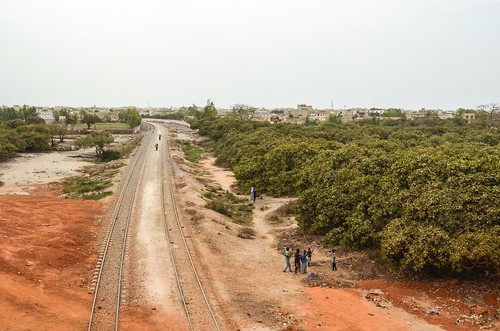
By the way, another sign of superiority of OpenStreetMap over Google Maps, is that the former has a dotted line for this yet-to-open highway. I have to leave it in Rufisque, where it is already operational. Rufisque is jammed and barely moving. Roundabouts rules are not respected by anyone, so they actually harm the traffic more than they help it. I avoid it by taking the narrow streets of the town, which have some charm, hiding old colonial buildings, similar to Saint-Louis, away from the main road.

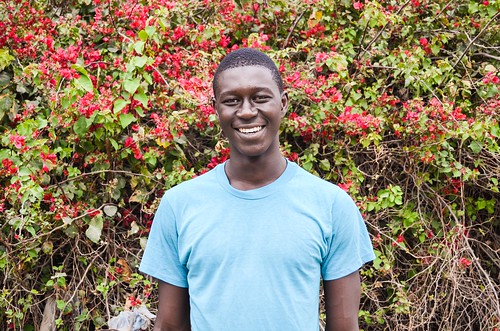
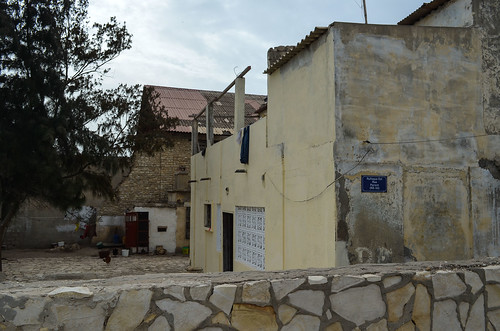

The town ends with the huge Sococim cement plant and takes me to Bargny. As the traffic becomes slightly more fluid, I have to react quickly to the honks of the vehicles behind me, meaning “jump out of the road coz’ I’m not gonna move for you“. Bargny is the last suburb town. Two kilometers further, I turn right and the peace instantly welcomes me. I am just a hundred meters away from the infernal road Dakar-Pikine-Rufisque-Bargny-Thiès and it is a different world. There are no more cars but goats and cows. There is silence. I feel something is slowed down. I realize soon that it’s because I am just watching the road ahead, and not moving my eyes incessantly between the sides, the rear mirror, the ground, and the road ahead. My stress and tension fades out like a laptop fan slows down when the video editing job is complete and the processor is idle.
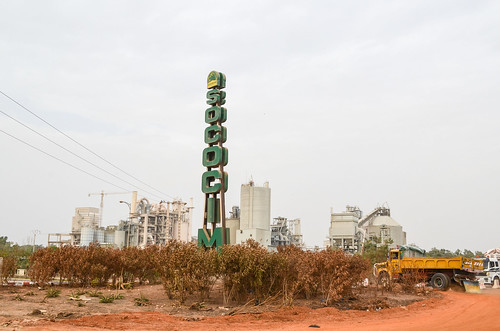
It feels good being back on small roads, and it feels even better being on a bike that feels new. It’s more in my brain that it feels new, as the shiny black tires are already red of the dust and laterite roads. Just 30 hours ago, I was moody about leaving my comfort zone and not really wanting to struggle in the dust again. I am now fully back into the nomadic adventure.
The first village I pass is Sendou. For a small village organized around a sandy piste, it has too many restaurants and rooms for rent. I see also many white faces driving cars. A guard explains me that this unusual sight is due to many Toubabs buying houses on the coast around Mbour. Most of the houses right on the clean beaches are owned by Europeans. They are big and that’s why many rent rooms and run restaurants.
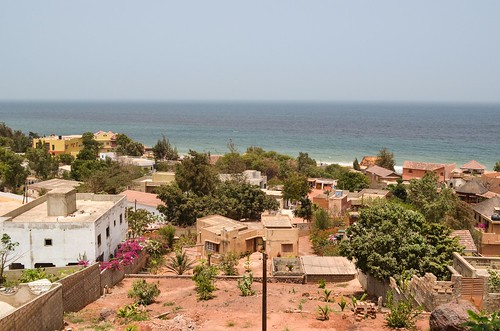
I stop for the night in the next village of Toubab Dialaw attracted by the sign of an authentic italian pizza.





Hi there!
I know this was quite a while ago now, but me and my partner are about to do a cycle from Dakar to Banjul. I’m a little concerned about getting out of Dakar, and I just wondered if there was any way of avoiding the major roads getting out of Dakar, or perhaps anywhere suitable to stay on the outskirts?
We will be arriving into Dakar airport, and then spending a day in Dakar, and setting off on our route the next day!
Thanks 🙂
Hi!
I see I managed to ride the highway before it opened. I’m afraid roads may have changed too much since. In general for safety and pleasure I’d recommend avoiding main roads and any road that has a good surface, which would make cars/motorbikes drive fast even on the shoulder. There must be local roads zigzagging their way out of Dakar.
Also, playing with rush hours: if you stay in the center, maybe leaving at 5 or 6am gets you empty roads out?
Staying on the outskirts is a strategy that I don’t like much, as I don’t like to “commute” in and out with my good bike (traffic, puncture risk in industrial areas, stress when I leave it unattended outside a shop). If I do that, I’d take public transport (or the ndiaga ndiaye in the case of Senegal) to visit sights and shops, it’s a great way to feel the city differently than on a bike.
Dakar to Banjul may be the most densely area of Senegal, so anyway you’d have to get accustomed to the traffic, i.e. to jump off the road if you feel an overtaking truck is not going to leave you space. I hope you can stick to small roads, stay safe!
Hello! I’ve just cycled from England to Senegal (In mboro now) with my Mum and your blog has been incredibly informative/entertaining/inspirational throughout our journey so far. We’re heading to Dakar and then Rio for more cycling! Thank you so much for keeping such a clear and detailed record – it’s far more than I’ve managed.. Congratulations on your achievement 🙂
Thanks! Please say Hi to Nicolas if you’re in the campement des Niayes in Mboro 🙂
All the best for South America!